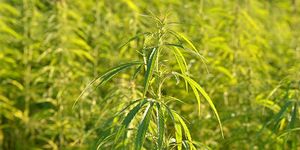Wait for Hemp Production Plans Before You Begin Planting
 The 2018 Farm Bill removes hemp from the Controlled Substances Act and enables states and tribal governments to develop hemp production plans. But you might want to wait until USDA updates its hemp provisions before planting seed.
The 2018 Farm Bill removes hemp from the Controlled Substances Act and enables states and tribal governments to develop hemp production plans. But you might want to wait until USDA updates its hemp provisions before planting seed.
The farm bill declassified hemp as a controlled substance. Under Section 12619, the definition of marijuana does not include hemp. Section 10113 defines hemp as “the plant Cannabis sativa L. and any part of that plant, including the seeds thereof and all derivatives, extracts, cannabinoids, isomers, acids, salts and salts of isomers, whether growing or not, with a delta-9 tetrahydrocannabinol concentration of not more than 0.3% on a dry weight basis.” Any hemp plants with a delta-9 tetrahydrocannabinol concentration (THC) of greater than 0.3% on a dry weight basis are considered marijuana and are still illegal under federal law.
Not legal yet
Although hemp is no longer a Schedule 1 drug, this does not mean it is legal to grow. To be legal, Section 10113 requires that a state, tribe or federal government develop a hemp production plan.
Section 10113 lays out two routes for a producer to begin growing hemp legally. The first is for a state or tribal government to regulate hemp production within their boundaries. This happens when a state Department of Agriculture submits a hemp production plan to USDA for approval, which outlines:
• The land where hemp is being produced, including the legal description of the property. The system will need to maintain land records for at least three years.
• Testing procedures demonstrating the hemp produced has less than 0.3% THC per dry weight basis.
• Procedures for destroying any plants and products with THC concentrations higher than allowed by law.
• Procedures to enforce the law.
• Procedures for conducting annual inspections of a random sample of hemp producers to verify hemp produced in the state does not violate the law.
• A system to convey hemp producers’ information to USDA.
• Certification that the state or tribe has the resources and personnel to carry out the requirements of the hemp production plan.
A producer must first comply with the state’s hemp production plan before legally growing hemp. These plans are expected to take a year to 18 months before they are finalized and approved by USDA.
If the state or tribal government does not have an approved production plan, a producer may still be able to produce hemp under a plan developed by USDA. For example, if the state does not have the resources or personnel necessary to carry out their plan, then USDA could step in and develop a plan for the state. But if state law still classifies hemp as a controlled substance, USDA will not be able to step in and develop a production plan, as Section 10113 explicitly allows states or tribal governments to prevent hemp production within their boundaries.
Producers who don’t provide a legal description of the land where the hemp will be produced can be found to be negligently violating a state, tribal government or USDA hemp production plan. Another example is failing to obtain the license or other authorization required under the plan before producing hemp.
Other potential violations will be more clearly defined as the provisions are implemented.
Producers can correct a violation by complying with a corrective action plan developed by the state, tribe or USDA. Three negligent violations in five years will result in being barred from producing hemp for five years. Section 10113 does not allow anyone with a felony drug conviction within the past 10 years to grow hemp.
Section 10114 allows for hemp products to be transported freely among states. Although states can still ban hemp products, they can’t limit transportation of hemp bound for another state.
Different states, different plans
How states are handling hemp is all over the map. Maine, Maryland, New York, Pennsylvania and Vermont have established hemp research programs allowed under the 2014 Farm Bill. Other states such as Connecticut and New Jersey have no laws on the books allowing for hemp production.
In all these states, the legislatures will have to act to ensure the appropriate state agency develops a hemp production plan. For example, in Maryland, the General Assembly will need to give the state Department of Agriculture the power to establish a hemp production plan. In Pennsylvania and Delaware, the departments of Agriculture already have the power to develop a hemp production plan and can generate such a plan once USDA announces the requirements.
Farmers will have to wait until USDA finalizes its requirements for hemp production plans and for states to develop those plans before growing hemp outside of existing research programs.
Goeringer is an Extension legal specialist with the University of Maryland. This article is not a substitute for legal advice.
Source: Dakota Farmer
